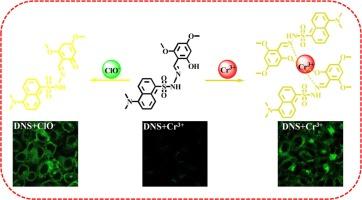用于感测 Cr3+/ClO- 的开启式 AIE 双通道荧光探针及其在细胞成像中的应用。
IF 4.3
2区 化学
Q1 SPECTROSCOPY
Spectrochimica Acta Part A: Molecular and Biomolecular Spectroscopy
Pub Date : 2024-11-17
DOI:10.1016/j.saa.2024.125444
引用次数: 0
摘要
以丹酰肼和 4,6-二甲氧基水杨醛为起始原料,合成了一种具有聚集诱导发射(AIE)特性的 Cr3+/ClO- 增强荧光探针 DNS(5-(dimethylamino)-N'-(2-hydroxy-4,6-dimethoxybenzylidene)-naphthalene-1-sulfonyl hydrazide)。该探针可在 H2O/DMSO (2:8) 溶剂体系中快速、选择性地检测 Cr3+ 和 ClO-。与 Cr3+/ClO- 结合后,探针的荧光明显增强,其他离子的干扰极小。经测定,Cr3+ 的检测限(LOD)为 5.36 × 10-7 mol/L,ClO- 的检测限(LOD)为 3.65 × 10-7 mol/L。通过约伯图、1H NMR 滴定和质谱分析,研究了 DNS 与 Cr3+/ClO- 的结合机制。此外,该探针的低细胞毒性和生物相容性表明,它具有在活细胞中检测外源 Cr3+/ClO- 和内源 ClO- 的潜力。DNS 显示了实时检测和生物成像应用的前景。本文章由计算机程序翻译,如有差异,请以英文原文为准。

A turn-on AIE dual-channel fluorescent probe for sensing Cr3+/ClO− and application in cell imaging
A Cr3+/ClO−-enhanced fluorescent probe, DNS (5-(dimethylamino)-N′-(2-hydroxy-4,6-dimethoxybenzylidene)-naphthalene-1-sulfonyl hydrazide), with aggregation-induced emission (AIE) properties was synthesized using dansylhydrazide and 4,6-dimethoxysalicylaldehyde as starting materials. The probe rapidly and selectively detects Cr3+ and ClO− in a solvent system of H2O/DMSO (2:8). Upon binding with Cr3+/ClO−, the probe exhibits a significant fluorescence enhancement, with minimal interference from other ions. The detection limits (LOD) were determined to be 5.36 × 10−7 mol/L for Cr3+ and 3.65 × 10−7 mol/L for ClO−. The binding mechanisms of DNS with Cr3+/ClO− were investigated through Job’s plot, 1H NMR titration, and mass spectrometry. Furthermore, the probe’s low cytotoxicity and biocompatibility suggest its potential for detecting exogenous Cr3+/ClO− and endogenous ClO− in living cells. DNS shows promise for real-time detection and bioimaging applications.
求助全文
通过发布文献求助,成功后即可免费获取论文全文。
去求助
来源期刊
CiteScore
8.40
自引率
11.40%
发文量
1364
审稿时长
40 days
期刊介绍:
Spectrochimica Acta, Part A: Molecular and Biomolecular Spectroscopy (SAA) is an interdisciplinary journal which spans from basic to applied aspects of optical spectroscopy in chemistry, medicine, biology, and materials science.
The journal publishes original scientific papers that feature high-quality spectroscopic data and analysis. From the broad range of optical spectroscopies, the emphasis is on electronic, vibrational or rotational spectra of molecules, rather than on spectroscopy based on magnetic moments.
Criteria for publication in SAA are novelty, uniqueness, and outstanding quality. Routine applications of spectroscopic techniques and computational methods are not appropriate.
Topics of particular interest of Spectrochimica Acta Part A include, but are not limited to:
Spectroscopy and dynamics of bioanalytical, biomedical, environmental, and atmospheric sciences,
Novel experimental techniques or instrumentation for molecular spectroscopy,
Novel theoretical and computational methods,
Novel applications in photochemistry and photobiology,
Novel interpretational approaches as well as advances in data analysis based on electronic or vibrational spectroscopy.

 求助内容:
求助内容: 应助结果提醒方式:
应助结果提醒方式:


